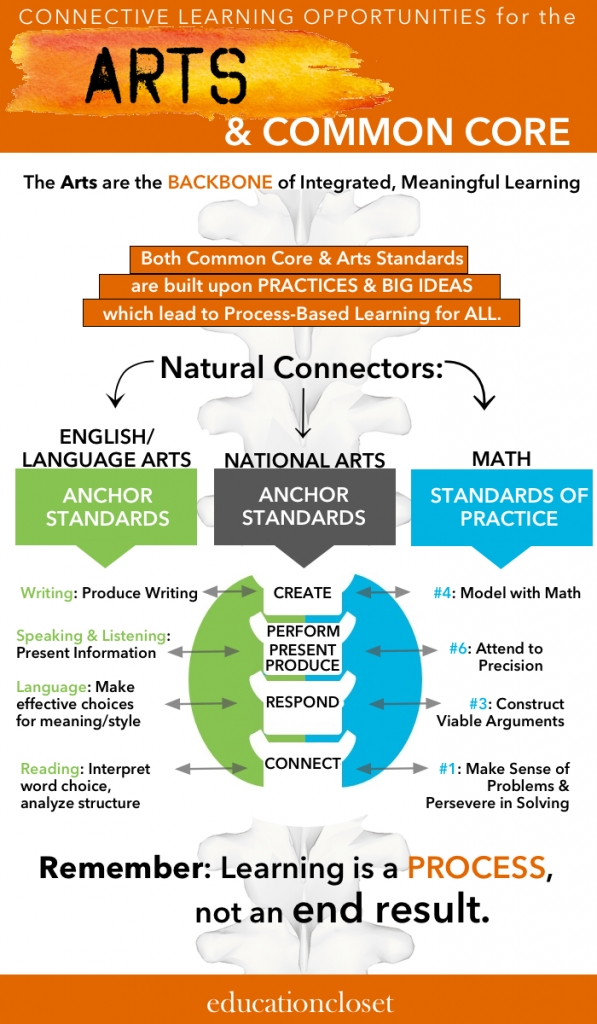Connective Learning Opportunities between the Arts and Common Core
4 Min Read • Common Core
Now with the new National Arts Standards officially released, we all get to look at how we can use these in our current work and in the expectations from Common Core. Many arts educators recognize that Common Core can be utilized through the arts by considering that artwork and compositions are forms of non-traditional text. This being true, that means that we can apply and English Language Arts standard to our work in the arts classroom.
For instance, whenever you have students look at a piece of artwork critically or listen to a piece of music for a specific instrument, you’re asking them to analyze text in your classroom. Today, I wanted to share with you yet another way to look at how to integrate Common Core and the Arts with integrity – through the PRACTICES that are embedded within all of the Standards!
Connective Learning Opportunities
To help with this discussion, I’ve created an infographic walking you through some examples. Take a look at how three sets of standards come together:

We start with the National Arts Anchor Standards/Domains. These are central to all of the arts disciplines. Then, we can look at how examples of the Anchor Standards from Common Core English/Language Arts and the Standards of Mathematical Practices connect.
English/Language Arts Examples:
These are the anchor standards that are used in grades K-12:
Writing Anchor: Produce Writing.
This is essentially creating a piece of writing, whether narrative or informational. In the arts, this translates into creating a composition. This could be a painting reflecting an understanding of the foreground and background. Or, it could be writing a brief composition in music, showing the use of quarter, eighth and sixteenth note rhythms.
Speaking and Listening Anchor: Present Information.
In this standard, students are expected to share their knowledge on a topic with the class through a presentation. Naturally, anytime students perform, present or produce a work, they meet this ELA anchor standard as well.
Language: Make effective choices for meaning/style.
This standard asks students to choose words and punctuation reflecting the genre or point of view of the piece. For instance, if students want to communicate that a character is asking a question, they use a question mark to reflect that. Similarly, in the arts, we ask students to respond to a work, artist, or expression through utilizing appropriate technique and skills.
Reading: Interpret Word Choice and Analyze Structure.
These two anchor standards ask students to think about what they are reading in context and to closely examine the meaning of the text. In the arts, this is reflected when we ask students to analyze a composition or when we use strategies such as “See, Think, Wonder”. We want our students to interpret and connect what they are experiencing in the artwork with their own understanding to make meaning for themselves.
Math Examples – Standards of Mathematical Practices
These practices are used and constantly referenced in grades K-12. Here are some select practices that make natural connections with the arts.
Practice #4: Model with Mathematics.
This is asking students to use their knowledge of mathematical skills and apply them to everyday life. In the arts, we ask students to use their understanding of proportion, fractions, and geometry and apply them in a new and different way when they are creating in our classrooms.
Practice #6: Attend to Precision.
In this practice, students are being asked to communicate clearly with others and to share the meaning of the symbols they choose. In the arts, this translates through student performance, presentation and/or production when we ask students to share their work with an audience. We want their finished work to represent their true reflection and intention.
Practice #3: Construct Viable Arguments.
Mathematically-speaking, this practice is asking students to use their past knowledge to make conclusions and logical decisions when presented with a new idea or problem. This is reflected through the arts when students are predicting what might happen in response to a visual, aural or kinesthetic prompt. It is also a natural by-product of the artistic reflection and critique process.
Practice #1: Make Sense of Problems and Persevere in Solving Them.
In math, students are asked to look for multiple ways of solving a problem and to not give up on the first try. In the arts, we ask students to stretch their current understandings and skills through connecting through other access points, such as cultural and historical context.
Hopefully, this brief look at just some of the examples from the anchor standards have given you some ideas for your own classroom. These are certainly not a comprehensive list, and we’d love to hear from you in the comments below if you have other connectors!



